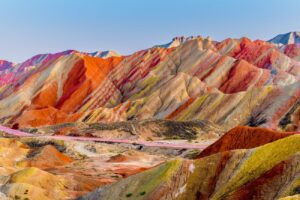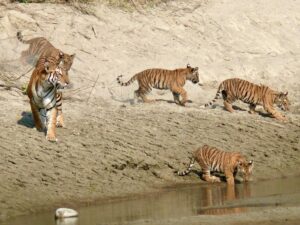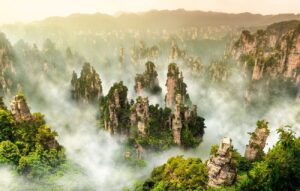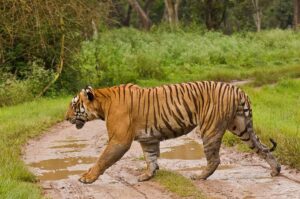Nestled in the remote mountains of Sichuan Province, Jiuzhaigou National Park is a landscape of breathtaking natural beauty. Known for its vivid turquoise lakes, cascading waterfalls, and snow-capped peaks, this UNESCO World Heritage Site draws visitors seeking a magical escape into one of China’s most picturesque regions.
The park’s most famous features are its stunningly vibrant lakes, which seem to shimmer in every shade of blue, green, and turquoise. The mineral-rich waters, combined with glacial runoff, create mesmerizing hues that change with the light and seasons. Here’s our comprehensive guide to Jiuzhaigou National Park;
Please Download Our Mobile App here.
Overview of Jiuzhaigou National Park
Found in the northern part of Sichuan Province in southwestern China, Jiuzhaigou National Park spans 280 square miles (720 sq km) of breathtaking landscapes. Recognized as both a UNESCO World Heritage Site and a World Biosphere Reserve, the park captivates visitors with its diverse natural beauty.
Situated within the Min Mountains, Jiuzhaigou Valley serves as the park’s centerpiece, with elevations ranging from 6,600 to 14,800 feet (2,000 to 4,500 m). The park is celebrated for its stunning, vividly colored lakes, cascading multi-tiered waterfalls, and towering peaks often adorned with snow.
Long Lake, the highest and deepest lake in the park, enchants visitors with its mesmerizing blue and green hues framed by majestic mountain scenery. Additionally, the Five Colors Pond, along with several other pristine water bodies, adds to Jiuzhaigou’s magical allure.
Wildlife in Jiuzhaigou National Park

Jiuzhaigou National Park is a biodiversity haven, sheltering more than 220 bird species alongside 74 varieties of state-protected plants and 18 endangered animal species. Among its rare inhabitants are the elusive giant panda and the playful snub-nosed monkey, both thriving in the park’s diverse habitats.
Bird enthusiasts will find plenty to marvel at here, especially during peak season when the rufous-headed robin makes its seasonal visit. The park’s high-altitude forests provide a permanent home to species like the Chinese grouse and the Sichuan jay, while the snowy creek laughing thrush can often be spotted near the park’s clear streams. Additionally, the lesser kestrel soars across the skies, adding to the park’s vibrant avian community.
Best Time to Visit Jiuzhaigou National Park
Jiuzhaigou National Park is a stunning destination throughout the year, with each season offering its own unique charm. However, autumn (September to early November) is the best time to visit. During this period, the valley transforms into a breathtaking canvas of colors, with vibrant orange sumac, golden birch leaves, red maple trees, and dark red wild fruits painting the landscape.
The foliage begins to show hints of color in late September, reaches its peak with vivid hues from late October to early November, and draws visitors from around the world. Since autumn is peak season, it’s wise to book hotels, flights, and guides at least two months in advance.
Spring (March to May) offers a different but equally captivating experience. As the snow melts from the mountains, the lakes brim with crystal-clear water, reflecting mesmerizing shades of blue and green. From late March to late April, peach blossoms add a delicate pink charm to the landscape, making spring an ideal time for nature enthusiasts.
In summer (June to August) Jiuzhaigou becomes a lush green retreat with deep blue lakes and cool mountain air providing relief from the heat. However, this is the rainy season, so checking the weather forecast and planning for sunny days will enhance the experience.
Finally, winter (November to February) blankets the park in snow, turning it into a serene, icy wonderland. Frozen waterfalls, particularly the Pearl Shoal and Nuorilang waterfalls, create magical scenes, and the deep blue lakes contrast beautifully with the snowy backdrop. Winter also sees fewer visitors, making it perfect for those who enjoy tranquility and off-season travel deals.
Getting to Jiuzhaigou National Park

Chengdu is the best gateway to this stunning natural wonder. After arriving in Chengdu, travelers have the option of flying or taking a high-speed train to reach Jiuzhaigou. Flying is quick, with a direct flight to Jiuzhai Huanglong Airport taking about an hour, followed by a scenic two-hour drive to the park.
However, flights can be less frequent during the off-season, and the overall travel time, including airport transfers, makes the high-speed train a more appealing choice. The train journey lasts between 1.5 and 2 hours and offers better value for money while providing the chance to enjoy the picturesque landscapes along the way.
Of the three nearby train stations, Huanglong Jiuzhai Station is the most convenient, with just a 90-minute drive to Jiuzhaigou Valley. Songpan Station is a solid alternative, although it requires a longer 2.5-hour transfer. Lastly, Huangshengguan Station is the least convenient, as it involves a 2-hour drive after the train ride.
Other Activities in Jiuzhaigou National Park
Jiuzhaigou National Park offers a wealth of activities for nature lovers and adventure seekers alike. Hiking is one of the best ways to immerse yourself in the park’s natural beauty. You can explore the three valleys forming the park’s distinctive Y-shape, with trails leading to scenic highlights like Long Lake and the magnificent Nuorilang Waterfall.
Rize Valley is often praised as the most picturesque of the three. The valley promises spectacular views around every corner. For a more relaxed way to see the sights, hop aboard a sightseeing bus, which takes you to key attractions, including the top of Zechawa Valley. The hop-on, hop-off system makes it easy to navigate the park’s many wonders.
Beyond these core activities, visitors can enjoy eco-tours, nature and wildlife excursions, or even a horseback ride through the park’s scenic terrain. Cultural enthusiasts shouldn’t miss the Tibetan villages and local temples, where they can experience traditional architecture and learn about the rich cultural heritage of the region.
Park Fees in Jiuzhaigou National Park

Jiuzhaigou National Park charges varying entrance fees depending on the season and age. For adults, tickets cost 220 RMB (about $30) during the peak season (from April 1 to November 15). During the off-peak season (November 16 to March 31) the park lowers the fees to 80 RMB (around $11).
Seniors between 60 and 69 receive a discounted rate of 110 RMB ($15) in peak season and 40 RMB ($5.50) in the off-season. Adults over 70 and children under six enter for free, though they need to collect a complimentary ticket at the office.
FAQs
How long to spend in Jiuzhaigou National Park?
iuzhaigou National Park, with its breathtaking landscapes spread across three scenic valleys, can be explored in just one day if you’re short on time. However, dedicating two days to the park allows for a more immersive experience, giving you the chance to appreciate the region without feeling rushed.
What is special about Jiuzhaigou?
Jiuzhaigou is often described as “Heaven on Earth.” The park is celebrated for its harmonious blend of crystal-clear lakes, cascading waterfalls, and dense, vibrant forests. This scenic valley, recognized as a UNESCO World Heritage Site in 1992, captivates visitors with its otherworldly beauty, where turquoise waters reflect the surrounding peaks like a living painting.
Conclusion
Jiuzhaigou National Park is more than just a scenic destination; it’s a natural wonderland that leaves visitors enchanted by its vibrant lakes, majestic waterfalls, and rich cultural tapestry. Hopefully, our guide has given you insight on all the relevant information to properly plan your visit.




